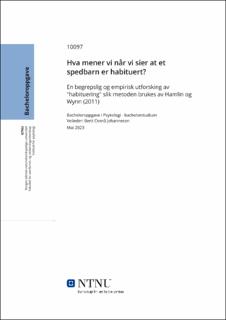| dc.contributor.advisor | Johannesen, Berit Overå | |
| dc.contributor.author | Viken, Anna Josefine | |
| dc.date.accessioned | 2023-07-11T17:20:17Z | |
| dc.date.available | 2023-07-11T17:20:17Z | |
| dc.date.issued | 2023 | |
| dc.identifier | no.ntnu:inspera:146342237:65022878 | |
| dc.identifier.uri | https://hdl.handle.net/11250/3077776 | |
| dc.description.abstract | Kiley Hamlin og Karen Wynn studerer spedbarns preferanser for prososiale fremfor antisosiale individer, og gjør dette ved å ta i bruk habituering som metode. Funnene deres har bidratt stort til forskningsfeltet innenfor eksperimentell utviklingspsykologi. I replikasjonene er det en viss variasjon i forskningsdesignet, men måten å benytte habituering på er beholdt. Oppgaven vil bruke et lokalt replikasjonsforsøk av Hamlin og Wynn (2011) som innfallsvinkel til å drøfte ulike aspekter ved habituering som metode. Problemstilling lander derfor på: en begrepslig og empirisk utforsking av «habituering» slik metoden brukes av Hamlin og Wynn (2011). Den vil gå nærmere inn på hva vi mener når vi sier at et spedbarn er habituert. Habituering har vært en av de mest fremtredende metodene når det kommer til spedbarns kognisjon (Colombo & Mitchell, 2009). I denne oppgaven vil jeg ta i bruk videomateriale fra et replikasjonsforsøk av Hamlin og Wynn (2011) for å systematisk observere oppmerksomhetsfaktoren hos spedbarna, for å kunne belyse habituering. Ut fra observasjonene vil jeg konkludere med at selv om habitueringskriteriet er oppfylt betyr ikke dette at det individuelle barnet er habituert. Bakgrunnen for dette er at det er individuelle forskjeller i hvorvidt og hvordan barnet flytter blikket under habitueringsperioden. Det kan derfor argumenteres for at det krever bruk av flere forskningsmetoder for å kunne konkludere innenfor eksperimentell utviklingspsykologi. | |
| dc.description.abstract | Kiley Hamlin and Karen Wynn study the preferences of infants for prosocial over antisocial individuals, using the method of habituation. Their findings have contributed greatly to the field of experimental developmental psychology. In replications, there is some variation in research design, but the use of habituation is retained. This thesis will use a local replication of Hamlin and Wynn (2011) as an approach to discuss different aspects of habituation as a method. The research question therefore focuses on a conceptual and empirical exploration of "habituation" as the method used by Hamlin and Wynn (2011). It will delve deeper into what we mean when we claim that an infant is habituated. Habituation has been one of the most prominent concepts in infant cognition (Colombo & Mitchell, 2009). In this thesis, I will use video material from a replication of Hamlin and Wynn (2011) to systematically observe the attention factor in infants to illuminate habituation. Based on observations, I will conclude that even though the habituation criterion is fulfilled, it does not mean that the individual child is habituated. This is based on individual differences in whether and how the child shifts gaze during the habituation period. It can therefore be argued that the use of multiple research methods is required to draw conclusions in the field of experimental developmental psychology. | |
| dc.language | nob | |
| dc.publisher | NTNU | |
| dc.title | Hva mener vi når vi sier at et spedbarn er habituert? - En begrepslig og empirisk utforsking av «habituering» slik metoden brukes av Hamlin og Wynn (2011) | |
| dc.type | Bachelor thesis | |
